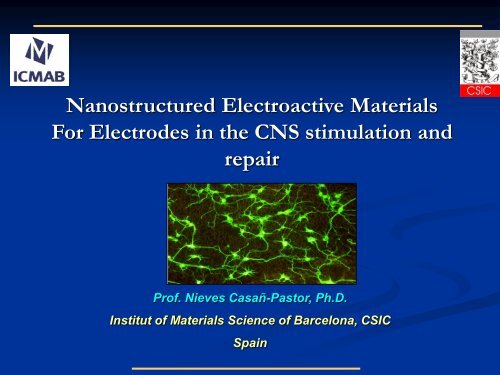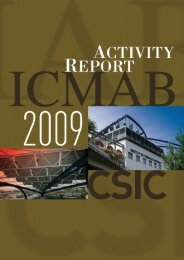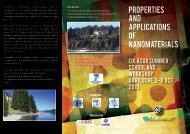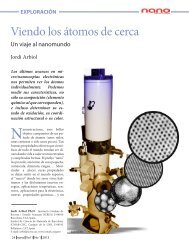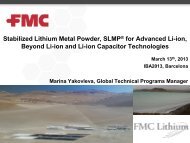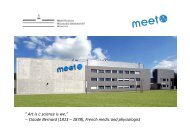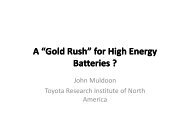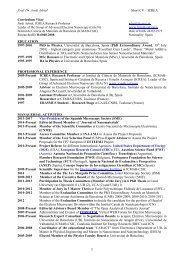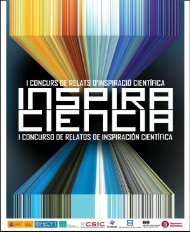April 9 - 5. Nieves_ICMAB.pdf - icmab csic
April 9 - 5. Nieves_ICMAB.pdf - icmab csic
April 9 - 5. Nieves_ICMAB.pdf - icmab csic
Create successful ePaper yourself
Turn your PDF publications into a flip-book with our unique Google optimized e-Paper software.
Nanostructured Electroactive Materials<br />
For Electrodes in the CNS stimulation and<br />
repair<br />
Prof. <strong>Nieves</strong> Casañ-Pastor, Ph.D.<br />
Institut of Materials Science of Barcelona, CSIC<br />
Spain
In collaboration with<br />
Hospital Nacional de Paraplejicos in Toledo<br />
Inst. Biomedical Sciences CSIC, Barcelona<br />
And Univ. Aberdeen School of Medical Sciences<br />
Finnancing CICYT (SPAIN)<br />
EU STREP<br />
CSIC
Nervous system and<br />
Electroactive Materials<br />
Prostheses/scaffolds<br />
Electrostimulation in the nervous system<br />
Inert Pt, Au RADICALS!!!!!!!!<br />
Which material <br />
-Electroactive<br />
-Biocompatible<br />
-Flexible
Deep Brain<br />
Electrostimulation<br />
Pt vs IrOx, pedot electrodes<br />
http://my.clevelandclinic.org/neurological_institute/<br />
Parkinson’s disease (PD),<br />
such as tremor, rigidity, stiffness, slowed movement, and walking problems.<br />
http://www.ninds.nih.gov/disorders/deep_brain_stimulation/deep_brain_stimulation.htm<br />
2007
Neuroblastoma and dendrite growth<br />
Growth cone directing <br />
REPAIR
Migration towards cathode in embryo cells (XENOPUS)<br />
http://www.abdn.ac.uk/ims/staff/details.phpid=c.mccaig<br />
Epithelial Cells migrate towards cathode<br />
WHAT IF CELLS ARE ON THE MATERIAL
WHICH MATERIALS
Most described materials in this field have a static property<br />
BUT THE MATERIAL MAY BE SEEN<br />
AS SOMETHING DYNAMIC<br />
ITS PROPERTIES MODULATED:<br />
ELECTROACTIVE<br />
ELECTROCHEMISTRY IS INTERFACE<br />
ALWAYS NANO !!!!!!
ELECTROACTIVE MATERIALS :<br />
C, Oxides, Conducting polymers…<br />
Active electrochemically<br />
Electrodes<br />
Mixed conduction<br />
Intercalation (Li+, O- , Na+, …)<br />
Redox Modulation of surface potential<br />
Applications: Bateries, FC, supercapacitors : Energy storage<br />
Sensors<br />
Electrostimulation<br />
Electronics<br />
Photovoltaics<br />
Electrochromism, electromechanics<br />
Artificial muscles……
An example : Li + ion batteries<br />
LiCoO 2 ↔ Li 1-x CoO 2 + xLi + + xe -<br />
Cathode<br />
All reactions occur at the interface<br />
Whatever this is : flat or pores…..<br />
C + xLi + + xe - ↔ Li x C<br />
Anode<br />
Ion diffusion : Interfaces<br />
Particle size and NANO
Li+ in lithium batteries<br />
Not only porosity or final nanosized
Electrochromism and conductivity switching<br />
by redox intercalation<br />
O<br />
O<br />
O<br />
O<br />
S<br />
S<br />
S<br />
S<br />
S<br />
O<br />
O<br />
O<br />
O<br />
O<br />
O<br />
O O<br />
A - O O<br />
+<br />
A -<br />
S<br />
S<br />
+<br />
S<br />
S<br />
S<br />
O O<br />
O O<br />
O O<br />
The electrochromic behavior is due to an electron transfer reaction taking place<br />
during the electrochemical oxidation and reduction of the polymer.
New Anodes<br />
NANO -----<br />
Sn alloys –Li- C
NOW! Li not only in PC<br />
Anode : TiOx NANO<br />
Fastest exchange More power<br />
Autonomy 150 Km<br />
Rechargable in 30 min<br />
(news 2009)
Intercalation in electrochemical systems :<br />
Not only small ions like Li+<br />
Not only positive ions<br />
Halides, (F - , Br - ), O -x
1991 Casañ et al <strong>ICMAB</strong><br />
Oxygen intercalation and mobility at room<br />
temperature also<br />
Electrochemical cell<br />
Semi to superconductor (Cu)<br />
Magnetic changes 300% (Mn)<br />
Oxygen enters in<br />
interstitial positions<br />
La 2 CuO 4 + d/n O -n La 2 CuO 4+d<br />
Ln 2 MnO 4 + d/n O -n Ln 2 MnO 4+d
Same process <br />
NEW PHASES by SOFT CHEMISTRY<br />
1999: First Ag-Cu oxide Ag 2 Cu 2 O 3<br />
(1)<br />
In the search of new superconductors:<br />
Replacing Ag by Hg<br />
New oxide Ag 2 Cu 2 O 4<br />
(3)<br />
by oxygen doping of Ag 2 Cu 2 O 3 !!!!<br />
(1) P. Gómez-Romero et al., Angew. Chem. 111, 1999, 544-6, Gómez-Romero, Casañ-Pastor et al, Inorg. Chem. 41, 2002,<br />
6604. (2) Gómez-Romero, et. al., J. Solid State Chem. 163, 2002, 151, (3) Casañ-Pastor et al. Electrochem. Comm. 4,<br />
(2002) , 684-689
Electrochemical Oxidation<br />
in NaOH (aq): nanoparticles in suspension<br />
Ag 2 Cu 2 O 3 Ag 2 Cu 2 O 4<br />
d = 7.01 g/cc<br />
-e - + O -2<br />
d = 7.16 g/cc
Ag 2 Cu 2 O 4 structure<br />
• 1 O atom “intercalated” per unit formula;<br />
• Pass from a 3D structure to a 2D one at r.t. !!!!;<br />
• Significant structure transformation and<br />
electronic delocalization Ag octahedral<br />
Ag 2 Cu 2 O 3 ; 3D<br />
Ag 2 Cu 2 O 4 ; 2D
Ag 2 Cu 2 O 4 vs its precursor 200 nm size part.<br />
• SEM<br />
Solid State Nano-transformations : Oxygen diffusion induced electrochemically<br />
Ag 2 Cu 2 O 3 Ag 2 Cu 2 O 4<br />
• HRTEM
I / A<br />
After been prepared, it has electrochemical transformations<br />
also in solid state .<br />
•CV Ag 2 Cu 2 O 3 pellet ; NaOH(1M); 0.35 mV/s<br />
Cathodic run<br />
0.06<br />
reduction<br />
A<br />
Ag + Ag 0<br />
0.04<br />
B<br />
C<br />
Cu 2+ Cu +<br />
0.02<br />
OCV<br />
0.00<br />
Cu + Cu 0 5<br />
-0.02<br />
Single oxides<br />
A’<br />
B’<br />
C’<br />
1.5 1.0 0.5 0.0 -0.5 -1.0 -1.5<br />
E / V vs. Au
INTENSITY (Arbitrary Units)<br />
Hydrothermal oxidation<br />
eff<br />
( B<br />
)<br />
1/ mol<br />
/ mol/emu<br />
Ag + Cu +2 with MnO4 - :<br />
Ag 2 CuMnO 4<br />
5<br />
4.5<br />
4<br />
3.5<br />
180<br />
3<br />
160<br />
140<br />
2.5<br />
2<br />
120<br />
100<br />
80<br />
60<br />
1.5<br />
40<br />
20<br />
0 50 100 150 200 250 300 350<br />
T (K)<br />
1<br />
0 50 100 150 200 250 300 350<br />
T (K)<br />
10 19 28 37 46 55 64 73 82 91 100<br />
2Theta (Degrees)<br />
Ferro and Antiferrom<br />
Coupling in layered<br />
phase<br />
N. Casañ-Pastor et al. ,<br />
J. Solid State Chem. , 179, 2006, 3883
When „Nano“ was not named Nano<br />
Technology can precede science<br />
Mayan BLUE<br />
Now we know: heat can embed aniline, a bright indigo<br />
chemical from the plant Indigofera suffruticosa, into<br />
the natural clay palygorskite, which provides a<br />
protective lattice.<br />
Really : HYBRID NANOCOMPOSITE Organic-<br />
Inorganic<br />
(Mg,Al) 2 Si 4 O 10 (OH)·4(H 2 O) clay mineral
Materials- Polymers<br />
• Polypyrrole and PEDOT<br />
Poly (3,4-ethylenedioxythiophene)<br />
electrochemically synthesized on Pt substrates<br />
With counterions as<br />
• Anionic surfactants (potentiostatic deposition)<br />
-PSS: poly (sodium 4-styrenesulfonate)<br />
• Aminoacids (dynamic deposition):<br />
-Glutamate<br />
-Glutamine<br />
-Glycine<br />
-Glutamine<br />
-Lysine<br />
Oxidation state modulation of Polymer coatings
Atomic Force Microscopy- Topography<br />
Current sensing AFM<br />
PPy-aminoacid films<br />
Polymer films < 1 m thick<br />
Coatings on transparent Pt (Ti) 12 + 5 nm<br />
Sample<br />
PSS As<br />
prepared<br />
Roughness<br />
RMS (nm)<br />
Peak to valley<br />
Maximum (nm)<br />
1<strong>5.</strong>5 86.3<br />
Glutamate 30.9 176.3<br />
Glutamine 16.9 107.2<br />
Glycine 26.9 16<strong>5.</strong>2<br />
Glutamic<br />
acid<br />
73.3 610.0<br />
1 μm<br />
Glutamate<br />
1 μm<br />
Glutamine<br />
Polypyrrole-PSS < 1 m thick<br />
Institut de Ciència de Materials de<br />
Barcelona<br />
0 200 400 600 800 1000 nm<br />
0<br />
100<br />
200<br />
300<br />
400<br />
500<br />
600<br />
700<br />
800<br />
900<br />
1000<br />
nm<br />
nm<br />
140<br />
130<br />
120<br />
110<br />
100<br />
90<br />
80<br />
70<br />
60<br />
50<br />
40<br />
30<br />
20<br />
10<br />
0<br />
1 μm<br />
Glycine<br />
1 μm<br />
Glutamic acid<br />
Current sensing measurements show how samples are much more<br />
conductive at the top of the grains for all cases
Cell cultures on polymers<br />
Ppy-PSS 4DIV<br />
Ppy-Glutamina 4DIV<br />
Ppy-Lisina 4DIV<br />
Ppy-Lisina pH 12 , 4DIV<br />
Aminoacid insertion improves material 500%
Steel/ppy/ electrolyte /ppy/steel<br />
electrochemical cell<br />
T.Otero, Chem. Comm. 1997
Materials: Electroactive oxides …<br />
Iridium Oxide IrOx<br />
Mixed Valence Ir (III) – Ir (IV)<br />
IV<br />
<br />
III IV<br />
Intercalation redox process<br />
Ir O2 xe xH H<br />
xIrx<br />
Ir O2<br />
Charge transference without<br />
injurious reactions or thermal<br />
Low effects impedance !!!<br />
Biocompatibility + good electrochemical properties
I(mA)<br />
Synthesis<br />
• Constant current<br />
35 A/cm 2 (* Petit et al. 1998)<br />
• Cyclyc Voltametry<br />
Voc – 0.55 V, 10mV/s 50 and 100 cycles<br />
Substrates:<br />
soda lime glass coated with Pt 12 nm<br />
(5nm Ti adhesion layer)<br />
Oxalic acid + K 2<br />
CO 3<br />
+ IrCl 3<br />
(CV, 0.55V, 10mV/s 1 cycle)<br />
0.8<br />
0.6<br />
0.4<br />
0.2<br />
0.0<br />
≈ 130 nm thick<br />
-0.2<br />
-0.1 0.0 0.1 0.2 0.3 0.4 0.5 0.6<br />
E (V) Vs Pt<br />
* PETIT, M.A; PICHON, V. Anodic electrodeposition of iridium oxide films. J. Electroanal. Chem. v. 444, p. 247-252, 1998
EQCM SÍNTHESIS of IrOx…<br />
Pulsed deposition<br />
m<br />
Q<br />
13.2 µg<br />
depositada<br />
oxidación<br />
Q/m : 6 to 4 e-/ Ir<br />
4.2 e - /Ir<br />
Aditional process: Oxalate oxidation to CO2<br />
Carga superior a la esperada …<br />
21
IrO x<br />
Similar to palygorskite<br />
≈ 130 nm thick<br />
Corriente<br />
aumenta<br />
IrOx.nH 2 O Oxohydroxide amorphous/channels<br />
Local structure<br />
similar to IrO 2 rutile<br />
Grazing angle XRay<br />
XAS (ESRF)
IrO x<br />
The microestructure depends of the<br />
synthesis conditions and oxidation<br />
state !!!<br />
Synthesys Conditions<br />
RMS<br />
(nm)<br />
35 A/cm 2 > 1000<br />
0.55V/2mV/s/17cycles <strong>5.</strong>6<br />
0.55V/10mV/s/50cycles 20.7<br />
0.55V/10mV/s/100cycles 84.5<br />
Modulation of Ir oxidation state<br />
Ir reduction at -0.23 V and simultaneous<br />
H + (H2O) intercalation assumed MW 13
In general IrO 2 crystallizes in the rutile form but in this case …<br />
GIXRD, XAS<br />
XPS y ATG<br />
XPS<br />
Amophous phase with local<br />
structure rutile<br />
Wet phase. OH - y H 2 O in the structure<br />
K ions in the structure, it is not residual.<br />
Is this K localized in channels <br />
Hollandite structure …<br />
Rutile<br />
Hollandite<br />
Proton, K, H 2 O, OH -<br />
Intercalation …<br />
Electrochemical Window of -1 V to 0.7V<br />
(no water redox processes)
Electrochemistry in AFM<br />
Current (mA)<br />
Iridium Oxide<br />
Electrochemistry in AFM<br />
CV scans_1st experiment<br />
-0.04<br />
-0.08<br />
-0.12<br />
-0.16<br />
-0.20<br />
0 1 2 3 4 5 µm<br />
0<br />
0.5<br />
1<br />
1.5<br />
2<br />
2.5<br />
3<br />
3.5<br />
4<br />
4.5<br />
RMS= 2<strong>5.</strong>7 nm<br />
5<br />
µm<br />
0 1 2 3 4 5 µm<br />
0<br />
0.5<br />
1<br />
nm<br />
150<br />
140<br />
130<br />
120<br />
110<br />
100<br />
90<br />
80<br />
70<br />
60<br />
50<br />
40<br />
30<br />
20<br />
10<br />
0<br />
nm<br />
140<br />
120<br />
0.12 V<br />
-0.06 V<br />
-0.33 V<br />
-0.24<br />
1.5<br />
2<br />
2.5<br />
100<br />
80<br />
-0.6 -0.4 -0.2 0.0 0.2<br />
E (V) vs Pt<br />
3<br />
3.5<br />
4<br />
4.5<br />
5<br />
µm<br />
RMS= 14.2 nm<br />
60<br />
40<br />
20<br />
0<br />
-0.57 V
Electroactive materials, electrochemistry, field applications, interfaces and cultures<br />
Hybrids<br />
IrOx encapsulated on PPy<br />
SEM<br />
Ir shows brighter<br />
Back-scattered Electrons<br />
Institut de Ciència de Materials de<br />
Barcelona NERBIOS Meeting, Aberdeen 21-22 otc 2009
IrOx-PEDOT<br />
IrOx-PPy
IrOx encapsulation with polypyrrole
Intensity (counts)<br />
Scaffold Hybrids IrOx<br />
–nanotubes and IrOXnanotubes<br />
-polys<br />
1,0<br />
0,8<br />
0,6<br />
IrOx + CNTs<br />
IrOx + PEDOT + CNTs<br />
IrOx AP<br />
Ir 4s<br />
O1s<br />
Ir 4d<br />
Ir 4d 5/2<br />
3/2 Ir 4f<br />
Ir 4p<br />
C1s 5/2 Ir 4f7/2<br />
3/2<br />
K 2s<br />
0,4<br />
0,2<br />
Cl 2s<br />
Cl 2p<br />
S 2s<br />
S 2p<br />
0,0<br />
1000 800 600 400 200 0<br />
Binding Energy (eV)
Intensity (cps)<br />
j(mA/cm2)2)<br />
INTERFACE MATERIAL - CELL<br />
Polylysine: Evidence of polypeptide adhesion<br />
• Both CV and XPS evidence the adhesion of P-L-Lysine to the PPy coating<br />
Electrochemical effect<br />
Not passivating<br />
DBS 0,75V as prep. samples<br />
1<br />
0.5<br />
0<br />
-2 -1.5 -1 -0.5 0<br />
-0.5<br />
-1<br />
-1.5<br />
-2<br />
phosphate<br />
phosphate p-<br />
lysine<br />
medium<br />
50000<br />
40000<br />
30000<br />
20000<br />
XPS N 1s<br />
N 1s<br />
PPY-PSS As prepared<br />
PPY-PSS AP<br />
with lysyne<br />
PPY-PSS AP<br />
with polilysyne<br />
x 10<br />
E(V) vs Pt<br />
-2.5<br />
XPS<br />
O 1s<br />
medium p-<br />
lysine<br />
10000<br />
0<br />
398 400 402 404<br />
Binding Energy (eV)<br />
Institut de Ciència de Materials de<br />
Barcelona
Intensity (cps)<br />
Oxides IrOx and polypyrrole with lysine and polylysine<br />
XPS<br />
18000<br />
16000<br />
14000<br />
12000<br />
10000<br />
8000<br />
6000<br />
4000<br />
2000<br />
O 1s Comparison<br />
*TiO O 1s<br />
2<br />
Ppy<br />
IrOx AP with lysyne<br />
IrOx AP with poliysyne<br />
TiO2 350ºC, 3x with lysysne<br />
TiO2 350ºC, 3x with polilysysne<br />
PPY-PSS AP with lysysne<br />
PPY-PSS AP with polilysysne<br />
IrOx<br />
528 530 532 534 536<br />
Binding Energy (eV)
Contact angle (deg)<br />
Contact angle (deg)<br />
Contact angle (deg)<br />
Surface Hydrophylicity: Contact Angle<br />
with PLL<br />
As prepared<br />
PPY-PSS<br />
PEDOT-PSS<br />
IrOx<br />
100<br />
Ppy-pss<br />
100<br />
Pedot-pss<br />
100<br />
IrOx<br />
90<br />
80<br />
As prepared<br />
with PLL<br />
90<br />
80<br />
As prepared<br />
with PLL<br />
90<br />
80<br />
70<br />
70<br />
70<br />
60<br />
50<br />
40<br />
water<br />
medium<br />
60<br />
50<br />
40<br />
water<br />
medium<br />
60<br />
50<br />
40<br />
As prepared<br />
With PLL<br />
water<br />
medium<br />
PLL decreases contact angle<br />
increases wetability<br />
θ<br />
A<br />
θ<br />
B<br />
Contact angle for IrOx samples without<br />
(A) and with PLL (B) in water
mA<br />
PLL Peptide adhesion 1 nm does not modify electroactivity<br />
Voltammetry.<br />
5<br />
cv_red_medio_ IrOx<br />
4<br />
3<br />
as prepared<br />
con PLL<br />
2<br />
1<br />
0<br />
-1<br />
-1,0 -0,5 0,0 0,5 1,0<br />
Ewe/V vs SCE
Electroactive materials, electrochemistry, field applications, interfaces and cultures<br />
Confocal Microscope (Fluorescence)<br />
PEDOT-PSS 4 μg/cm 2 PEDOT-PSS 28 μg/cm 2 IrOx 4 μg/cm 2<br />
Sample<br />
Integrated intensity<br />
(arbitrary units)<br />
PEDOT-PSS 4 μg/cm 2 (5,04 ± 2,25)·10 5<br />
PEDOT-PSS 28 μg/cm 2 (2,75 ± 0,96)·10 7<br />
* Marker: FITC<br />
IrOx 4 μg/cm 2 (1,50 ± 0,52)·10 6<br />
Institut de Ciència de Materials de<br />
Barcelona NERBIOS Meeting, Aberdeen 21-22 otc 2009
Atomic Force Microscopy (contact mode)<br />
with poly-L-lysine<br />
WEAR TESTS on Au and TiO 2 flat facet<br />
TiO 2 rutile 1 nm thickness PLL<br />
Au
Interdigital patterns by UV lithography<br />
PPY on Pt patterns<br />
Screen printing<br />
electrodes<br />
1. Substrate treatment<br />
Humidity<br />
2.- UV-Resin deposition<br />
3.- UV- insulation<br />
PPY-PSS<br />
4.- Developing<br />
<strong>5.</strong>- Platinum<br />
deposition<br />
6.- Lift-off<br />
7.- Electrodeposition
Cultivos celulares (células primarias embrionarias) …<br />
Rata Whistar Embrión E14/18 Córtex Siembra sobre el<br />
material<br />
Lamelopodia<br />
Neuritas<br />
Inmaduras<br />
Formación<br />
del Axón<br />
Dendritas<br />
múltiples<br />
Formación de<br />
las Dendritas<br />
Maduración<br />
Ramifica<br />
ciones<br />
Axón<br />
8
Neural cortex Cell cultures on polymer<br />
100 m<br />
PPY-DBS (Surfactant) 100 4DIVm<br />
Control 4 DIV (borosilicate glass) PPY-DBS (Surfactant) 4DIV<br />
Cells grow better on aminoacid<br />
containning polymers vs. those<br />
with surfactants<br />
Living cells statistics<br />
(25000 neurons/cm 2 original seeding)<br />
100 m<br />
100 m<br />
35000<br />
30000<br />
PEDOT-PPy Lysine 4DIV<br />
PEDOT-PPy Glutamine 4DIV<br />
25000<br />
20000<br />
15000<br />
Neurons/cm 2<br />
10000<br />
5000<br />
0<br />
PPy DBS<br />
PEDOT-PPy-<br />
Glutamine<br />
PEDOT-PPy-<br />
Lysine<br />
Control<br />
Material
There is no inhibition in the dendrite<br />
growth<br />
Neural cortex Cell cultures on IrOx<br />
Cerebral Cortex of embryos of Whistar E14 rats<br />
Survival is statistically<br />
equivalent to the control<br />
Good cell survival, adhesion, proliferation up to 4 days…and more
NEURONS GROWTH from Cerebral Cortex of embryos of Whistar E14 rats<br />
IrO x<br />
(Ir-Ti)O x<br />
There is no inibition in<br />
the dendrite growth<br />
4DIV<br />
Survival is<br />
statistically<br />
equivalent to the<br />
control<br />
Cell survival improve when Ir<br />
content increase
Surface potential may also be modified in situ !<br />
Material in the media<br />
Or<br />
Material as substrate and electrode
http://www.abdn.ac.uk/ims/staff/details.phpid<br />
=c.mccaig<br />
Epithelial Cells migrate towards cathode
I/mA<br />
Surface potential may also be modified in situ<br />
IrOx<br />
0 min<br />
Cultures<br />
Rat Cortical neurons<br />
3 min<br />
E-18<br />
Neurobasal + B27<br />
DC -0.2V<br />
DC ON<br />
-15 μA -0.1μA<br />
Q = 0.84 mC<br />
6 min<br />
15% IrOx capacity<br />
10 min<br />
6,00E-01<br />
5,00E-01<br />
4,00E-01<br />
3,00E-01<br />
20x<br />
2,00E-01<br />
1,00E-01<br />
0,00E+00<br />
-1,00E-01<br />
-2,00E-01<br />
IrOx MC -<br />
0 50 100 150 200<br />
time / s<br />
OFF<br />
14 hours after
An example: STIMULATION<br />
ON PEDOT-PSS HEPARIN CATHODE
Electric field modulation in nanoparticles or nanostructured coatings<br />
-Control of doping state/redox potential may change the physical properties largely.<br />
Applicable to surfaces acting as electrodes..<br />
-Intercalation achieved yielding to solid state reactions and new phases<br />
- Neural cells grow well in electroactive materials and survive in both<br />
OXIDES and AMINOACID containning POLYMERS.<br />
-Peptides absorb in both types of surfaces<br />
-Electroactivity is preserved after peptide adhesion, and is not modified by it<br />
- IrOx as an open structure with channels allows ion intercalation during redox changes,<br />
-Polymers behave also as an open structure allowing the same type of behavior<br />
-Modulation of the surface oxidation state and electrical potential is posible.<br />
Minimal changes occur in topography, hydrophilicity, or structure in IrOx , max in polymer
People involved in this work<br />
Dr. N. Casañ, Ph.D.<br />
Dr. J. Fraxedas<br />
Dr. P. Lozano<br />
Nina Carretero<br />
Dr. Ll. Abad<br />
MSc. A. M. Cruz<br />
Dr. C. de Haro<br />
MSc. J. Moral


